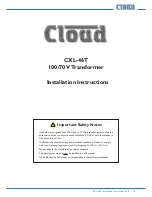
Honeywell
COMPONENT MAINTENANCE MANUAL
PART NUMBER 964-0452
I.B.1516A Page 39
Mar 30/01
23-12-01
The actual value can be shorted to ground at N5.3 with V38, thus deselecting
the average power control.
For VSWR control, the weighted sum of the FORWARD and REVERSE signals
is compared with reference voltage, VREF, by means of operational amplifier,
N3-A. The following equation applies at the initiation threshold of the control:
2.14 * F 4.09 * REVERSE – 2.49 * VREF = U
N3.1
≈
+0.3V
For the reverse power control, the REVERSE signal is compared at the opera-
tional amplifier, N3-D, with the reference voltage, VREF. The following equation
applies at the initiation threshold of the control:
8.00 * REVERSE – 2.68 * VREF = U
N3.14
≈
+0.3V
The dissipated power control restricts the junction temperature of the HF final
stage transistors by reducing the output power if the dissipated power is very
high, owing to unfavorable external operating conditions, such as mismatching,
high supply voltage, or high ambient temperatures. In this context, the signals,
FORWARD, VSFS (a measure of the supply voltages of the HF final stage tran-
sistors), CSFS (a measure of the final stage current), and TSFS (a measure of
the heat sink temperature at the final stage transistors) are compared with ref-
erence voltage, VREF, at operational amplifier, N2-D. The output signal of N2-D
is guided via the low-pass, switched operational amplifier, N1-B, to avoid a re-
spond of the dissipated power control at short HF peaks.
The following equation applies at the initiation threshold of the control:
2.30 * VSFS + 4.07 * CSFS + 3.70 * TSFS – 1.47 + FORWARD – 5.50 * VREF
= U
N1.7
≈
+0.3V
For the overcurrent control, the CSFS signal is compared with the reference
voltage at operational amplifier, N2-C. To prevent the control from responding
with short current spikes, the CSFS signal is supplied to the input of the opera-
tional amplifier via R75 and C56 after passing through a low-pass filter. The fol-
lowing equation applies at the initiation threshold of the control:
4.15 * CSFS – 1.58 * VREF = U
N2.8
≈
+0.3V
All the control branches described so far are combined by means of diodes, V8,
V23, V29, V30, V6, and V31, to form the DIODES signal in such a way that the
voltage at the DIODES signal is always determined by the control branch with
the highest output voltage.
The only exception in this context is undervoltage control. The VSFS signal is
compared with reference voltage, VREF, at operational amplifier, N2-B. The fol-
lowing equation applies at the initiation threshold of the control:
1.045 * VSFS = U
N2.7
≈
+4-3V (with high power stage)
Diode, V7, begins to conduct with this voltage at the output of the operational
amplifier, and the voltage at N2.4, and consequently, also the SPRFP control in-
put are steadily decreased as the voltage at VSFS is reduced. This results in the
peak power control being adjusted to a lower set value with a low operating volt-
age, and thus, the HF final stage transistors are not overdriven.
Page 61















































